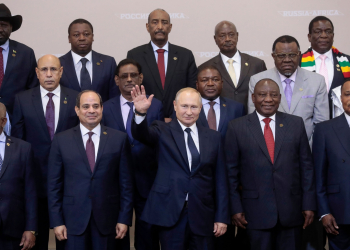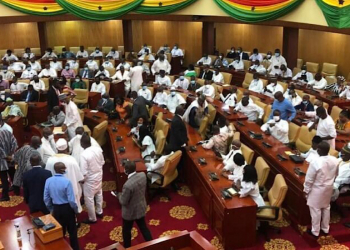Dear Mr. President, usually it is the brightness of a day that will pre-dispose one to want to write a letter to you, mainly because all those (or almost, nearly all of them) who come near you or try to catch your ear or attention only wish to win your favour and so will want the day to be bright even if it is not.
In fact, they will portray the bleak day as bright, just so they will stay in your good books or even get into it. Yet you have been in leadership long enough to know that that is an affliction of leadership, so who is Ti-Kelenkelen to try to lecture you on anything.
Hence my wish, Sir, is neither to bore you nor remind you of a bleak aspect and even slippery terrain of the position you occupy. The reason is to draw your attention to an issue that obeys the multi-stranded Ga philosophy: “Fiofio ni adido ke ye-o gbee tue” – Gradually is what the housefly uses to eat the dog’s ear. The English version of our preferred strand in that bundle of philosophy is “Little drops of water make a mighty ocean.”
And then the singular goal, Sir, is to draw your extremely-busy attention to the fact that “A stitch in time saves nine,” and, as Justice Kwame Afreh explains in his judgement on the Quality Grain Case, if you do not stop a developing problem and the state must later spend more money to stop the bigger problem, the amount is a loss and you are a culprit of causing financial loss to the state.
Sir, Ti-Kelenkelen has been watching an almost innocuous drama unfold and at the centre of that entire event is the brass plates bearing adinkra symbols and used to decorate the front building at your office, Office of the President or Flagstaff House on Africa Liberation Road, Accra. The brass plates are, one by one, falling off, and there is a direct but not readily-obvious relationship between two facts – one, the fact of that event and it is accrual over time, and two, the fact that apart from Nkrumah you are the next president who, up-to-date, has given this country a comprehensive and holistic development agenda.
Looking at the straight lines of the structure exposed by the falling brass plates it is easy to see why the designers installed the brass plates at all. The brass plates design makes the building attention catching and one cannot help but look at it when walking or in a vehicle passing by; unless, of course, one is afflicted with the needlessly caustic partisan politics we do in this beloved country of ours. Thus it was easy to notice when one brass plate and then two and then three fell off in the middle of 2016 when John D. Mahama was President. Today, about a year on, possibly, more than one hundred have fallen off.
And, interestingly, there is a scaffold mounted right where the brass plates are falling off; as if work men and women are ready to go to work on it tomorrow. Yet, believe it or not, the scaffold has been there since the days of Mahama. If the event started with one brass plate falling off and then two and then three and now we have about one hundred down, then we are approaching a disaster that strangely but appropriately can be called dilapidation. Yet we are talking about the Office of the President.
First, Sir, considering the amount of money that has reportedly been spent on Flagstaff House in a period of ten years, it is strange that the brass plates are coming off. It brings to mind a very simple but cogent point you made at the last Workers’ (May 1) Day celebration at the Black Star Square in Accra. Permit me to rephrase and paraphrase you, Sir. Virtually nothing fell off any of the buildings at Job 600 or State House, where Parliament is currently housed, till workmen and women, about two-and-a-half decades ago, actually started pulling off parts to re-build it for other uses. Yet Kwame Nkrumah built State House in the 1960s, originally for the maiden Organisation of African Unity (now Africa Union) Conference, but which was eventually moved to Addis Ababa, Ethiopia.
Ironically, if we are supposed to be progressing with the passage of time then we are handed a paradox when we compare State House to the (I think) 2008-completed Flagstaff House whose brass plates are already falling off. It reminds me of a subtle and apt observation made by Professor Kofi Ackah, Head of Department of Philosophy and Classics, University of Ghana, Legon. He writes that one “important but ignored [fact] about pre-industrial antiquity… is that modern does not necessarily or always mean better…” The tragedy, which you stated by implication on that May Day, Mr. President, is that modern should actually mean better.
Originally, the Kufuor administration told us, Flagstaff (or Jubilee) House was billed to cost $30 million. It was a soft loan given Ghana by India along with very flexible terms of payment. Knowing the limitations of the infrastructure at the Osu Castle few – from monitoring speakers on radio and television – objected to the idea. Interestingly, it was an Indian contractor who did the construction, since, as with most loans, the contractor came with the financial package. Hence it was strange when about a year-and-a-half into the job the then Chief of Staff who Kufuor had made Minister of State, Kwadwo Mpiani, went to Parliament to ask for more money to complete the project. That raised several issues.
One, it was as if the Governments of Ghana and Indian did not hire architectural engineers to make drawings of and costing of the project before the contract was awarded and construction commenced. Two, when Mpiani asked for the additional money to complete the project, the National Democratic Congress (NDC) minority in the House were right on point when they pointed out that the minister must first account for how the initial $30 million was spent. Mpiani’s response showed him as someone who carried – no, actually wore like a cloak – the impression that no one had the right to hold him accountable for how he spent the people’s money. Eventually, the New Patriotic Party (NPP) majority used their numbers to pass the documents by which Mpiani was demanding more money.
And yet, three, it was the state, the people of Ghana, owners of this country, who were never told the true story of the expenditure on the re-construction of Flagstaff House into this new Office of the President. Hence it was heart-warming when John E. A. Mills became President in 2009, and some of his appointees made statements to the effect that things have been hidden from them, the people, as far as that re-construction is concerned.
One of Mills’ deputy Ministers, Kobby Acheampong, said on radio that available documents show that Flagstaff House actually cost the Ghanaian taxpayer $200 million. And he added that the Mills administration will investigate the matter. That was welcome news, because probity and accountability is one of the foundation stones of the Constitution of the Republic of Ghana. Yet that investigation never happened or if it did the Mills administration never disclosed to Ghanaians what they discovered.
That brief history shows one thing, Sir, today the people of Ghana do not know how much Flagstaff House cost us. That is one of the issues of old waiting to be dealt with, because it is the right of Ghanaians to know.
Join GhanaStar.com to receive daily email alerts of breaking news in Ghana. GhanaStar.com is your source for all Ghana News. Get the latest Ghana news, breaking news, sports, politics, entertainment and more about Ghana, Africa and beyond.




